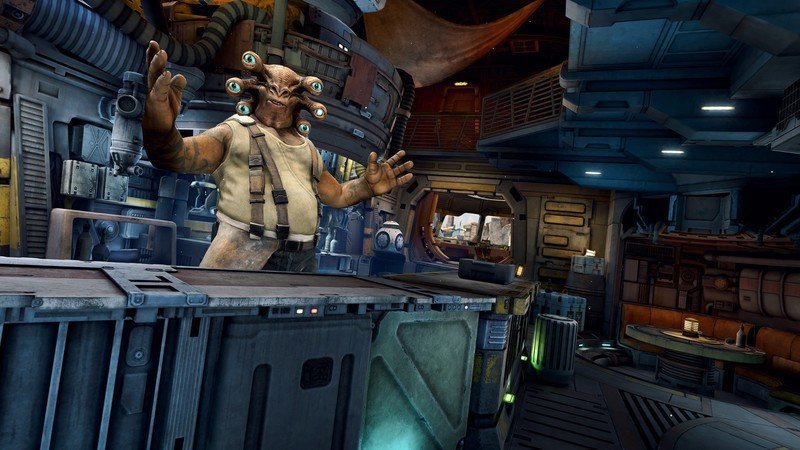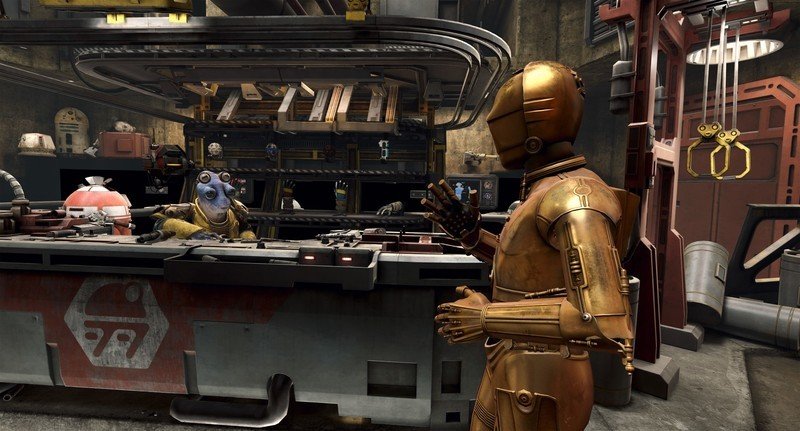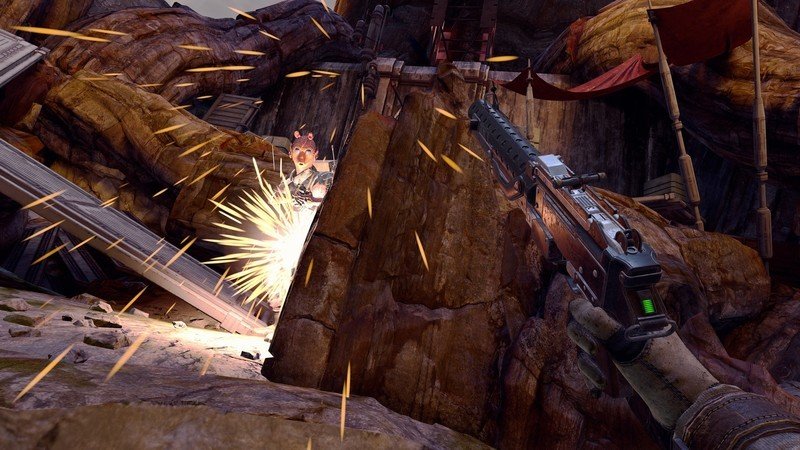Android Central Verdict
Bottom line: Part 1 of Star Wars: Tales From the Galaxy's Edge delivers in ways we had hoped and exceeds expecations in many ways. Hours of fascinating stories, characters, quests, combat, and puzzles await in this VR-exclusive action-adventure game.
Pros
- +
Visually and audibly pleasing
- +
Expansive combat mechanics
- +
Lots of side missions and collectables
- +
A detailed world to explore
- +
Stories told across multiple timelines
- +
Great new characters and voice work
Cons
- -
Some mechanics are a bit clunky
- -
Weapons don't feel like they have much weight
- -
Could have used more stories from Seezelslak
Why you can trust Android Central
Star Wars: Tales From the Galaxy's Edge marks the release of the second major VR-exclusive Star Wars series, following up the successful Vader Immortal trilogy from 2019. The same team behind that title has branched out in a significant way, moving from the highly-linear and depressingly-short Vader Immortal main story to a game that lasts several hours and takes you to dozens of different locations throughout the entire experience. Tales From the Galaxy's Edge is an Oculus Quest family exclusive game that takes place on Batuu, centering on the same Blackspire Outpost and Seezelslak's Cantina that can be found in Disney theme parks in Florida and California.
The team seems to have taken the specific criticisms of Vader Immortal to heart when designing Tales. Everything from the voicework to the action is significantly improved from that game, yet it still is able to hone what made that series so powerful: the scale. This time around, however, we're not just walking through centerpiece moments in a heavily-scripted story — Tales From the Galaxy's Edge takes place over a large span of time, from the High Republic era several hundred years before the Star Wars theatrical prequels, to events happening smack dab in the timeline between theatrical Star Wars Episodes 8 and 9.
Tales puts you in the shoes of a droid repair technician who has fallen in with the Guavian Death Gang and, in proper crime syndicate fashion, has gotten on their bad side and is hunted down no matter where they go. The main story is a very different experience from Vader Immortal, which primarily saw you using a Lightsaber and Force powers most of the game. While some of Seezelslak's stories will put you in the shoes of Force-wielding Jedi from The High Republic era, the bulk of this game is spent shooting space pirates with blasters and scavenging ingredients from Batuu for snacks at the cantina. It's a brilliant adventure with a few quirks here and there but, ultimately, is the next must-have Star Wars VR game.
Surprisingly large scope
Star Wars: Tales From the Galaxy's Edge: What I like

| Category | Tales From The Galaxy's Edge |
|---|---|
| Title | Star Wars: Tales From the Galaxy's Edge |
| Developer | ILMxLab |
| Publisher | Oculus Studios |
| Genre | Action Adventure |
| Platforms | Oculus Quest, Oculus Quest 2 |
| Game Size | 5.69GB |
| Play Time | 6-8 hours |
| Players | Singleplayer campaign |
| Release Date | November 19, 2020 |
| Launch Price | $25 |
You may be asking yourself what makes Star Wars: Tales From the Galaxy's Edge different from the Vader Immortal trilogy. The answer is everything but, in a nutshell, scope is the grandest change. When Vader Immortal: Episode 1 released on May 21, 2019, many gamers were ridiculously excited to finally get a story staring Darth Vader in the only medium that could truly make you understand how terrifying he really is: VR. Imagine our collective disappointment when the first episode was completed in under 45 minutes, with subsequent Episodes 2 and 3 lasting only around 30 minutes apiece.
Arguably, the real reason to buy these games was the Lightsaber Dojo, and it turns out that the same guy who oversaw the Lightsaber Dojo, Jose Perez III, is the director for Tales From the Galaxy's Edge. Instead of a linear story filled with scripted events and small, curated areas to progress through, Tales opens up not only to a much broader world on the planet Batuu, but also enters several Star Wars historical eras told through stories — experienced via first-hand gameplay — all with side quests, challenges, and missions throughout.
My expectations of scope were consistently exceeded as I made my way through the game
My expectations of scope were consistently exceeded as I made my way through the game, assuming it had to end just around the corner and I was going to be disappointed at any minute. Needless to say, after 2 days of playing until my Quest 2's battery died, I still hadn't unlocked the first major story sequence from Seezelslak that would invariably take me to The High Republic time period. Not only that, but I still hadn't unlocked the droid repair bay, hadn't yet met C-3PO, R2-D2, Yoda, or any one of the well-known major characters in this story.
Get the latest news from Android Central, your trusted companion in the world of Android
It's these new tales on new planets, in-between movies, and in entirely new timelines that really make Tales From the Galaxy's Edge shine
Surprisingly still was the fact that I didn't even mind taking so long to get to these opportunities because the new characters introduced, especially Seezelslak, had me wanting more encounters with them rather than the familiar faces that we always seem to find in Star Wars adventures. It's these new tales on new planets, in-between movies, and in entirely new timelines that really make Tales From the Galaxy's Edge shine. I certainly didn't expect a game that takes place between movies in the worst Star Wars timeline (between Episodes 8 and 9, to be exact) to be the first title to give us a look at the upcoming glories of The High Republic era.
The breadth of gameplay offered throughout Tales fits perfectly with the impressive scope of the story and settings, as you'll find yourself blasting Guavian Death Gang members while repairing droids and solving puzzles one minute, and another minute you'll be chilling with Seezelslak in the cantina while throwing darts and scaring off Porgs. In fact, Seezelslak might be my single favorite character introduced into Star Wars lore in some time — much of that is owed to the intriguing dialog and voiceover work by actor Bobby Moynihan.
Just watching Seezelslak talk is entertainment enough, with his 6 5 eyes looking around, moving as realistically as you would expect from a hulking extraterrestrial. It really makes you appreciate the fact that Seezelslak is friendly because his massive, 8ft-tall frame would easily fit in as a formidable boss fight were the situation different. In fact, this sense of scale is used incredibly well throughout the game as tiny Guavian Death Gang droids sneakily appear in the sky, often unnoticed because of their diminutive size.
Stepping out into The Wilds of Batuu as a humble droid repairman only proves that the Outer Rim in Star Wars is just as wild as anything cooked up in space westerns like Firefly. Guavian Death Gang members and hostile droids appear at every turn, and the arenas are, once again, surprisingly dense and well populated. While the initial flow makes the game seem very linear, that facade is quickly shed the moment you step into one of the areas where a battle ensues, as you'll regularly find branching paths that take you above or behind the action, giving you the ability to change up your play style.
Fitting with the rest of the experience, I was pleasantly surprised to find battles to be challenging and strategic; much more like the Lightsaber Dojos in terms of skill needed to complete battles on hard difficulty. 2 shots from a blaster on hard and you're dead, returning to the previous checkpoint and being forced to rethink your strategy. You've also got a hoverpack that allows you to move vertically, helping to avoid blaster fire by flying up into the air, move between levels on cliffsides, and find secrets along the way.
I finally understand why Stormtroopers can't ever seem to shoot anything; blasters can be horrendously inaccurate.
I also finally understood why Stormtroopers can't ever seem to shoot anything; blasters can be horrendously inaccurate, especially when going for rapid-fire. One shot might land straight on, while other shots are almost always just a bit off-center. You can always melee enemies if blasters don't suit you, although the selection of over half-a-dozen weapons certainly changes up combat.
But my favorite part of the combat wasn't the expansive multi-tiered areas or the interesting selection of blasters — it was the training remotes. You might remember these oddly-named floating orbs from Star Wars Episode IV: A New Hope. Yes, the very same ones that Luke Skywalker was honing his force acuity with are present in this game and can be used as sidekicks during battles. The game features several different models, each with a different colorway, which all perform separate functions.
Take one of these handy droids out of your inventory and toss it in the air to begin — it'll follow you to its death, delivering supressing fire so you can move around arenas, identifying targets that can be seen through your visor's augmented reality lens, or even just blowing up in enemies' faces for a grand finale. What's more is that you can repair these droids with your handy multi-tool, which is also used to solve puzzles throughout the game.
Visually, the game absolutely shines on the Oculus Quest 2. Being a Quest family exclusive is a big departure from Vader Immortal, which launched on Quest and PC, later to be ported to the PSVR on PS4. Being on Quest means the level of visual fidelity isn't quite what you'd find on a PC, and there's no advanced physics modeling like you'll find in something like Half-Life: Alyx, but what's here really does look gorgeous.
Visually, the game absolutely shines on the Oculus Quest 2
Textures are high-resolution, models all look detailed and exquisitely modeled, and the realtime lighting and ultra-crisp resolution on Quest 2, in particular, look far better than I would have expected. The density and placement of objects is, surprisingly, not affected by their quality at all and lend to a feeling of the world being alive. Most importantly though, animations are quite complex and look absolutely fantastic, even holding up when you get up-close and personal with characters.
A little rough around the edges
Star Wars: Tales From the Galaxy's Edge: What I don't like

While I never felt like the fidelity of the combat in Vader Immortal needed any changes, the blaster handling in Tales From the Galaxy's Edge could use a tad bit of work. I found my negative opinion of the gun handling wane over time, but it still doesn't feel quite as realistic or visceral as leading shooters like Half-Life: Alyx. The guns don't have any real weight or kickback to them, and I often felt like I couldn't get too close to walls or cover because of large hitboxes on objects, resulting in me shooting the edge of a rock that I was hiding behind rather than the enemy I was aiming at.
The snap-grabbing mechanics for these guns often requires you to be too precise
If you've never played a game like Half-Life: Alyx in VR, you may not find this to be quite as big of a deal, but Valve certainly spoiled players this year with the gun handling in that game. Inventory management, too, can feel very clunky at times. You can holster one gun on each of your hips in the game, grabbing them Han Solo style to shoot enemies as they appear. The problem is that the snapping mechanics for these guns often requires you to be too precise, as you need to grab the handle of the gun rather than just somewhere on the gun itself.
This precision issue winds its way into other objects in the game world, as well. Picking up items, for instance, can feel just as clunky. While you are able to point to objects a few feet away and pick them up (which helps keep things from getting stuck in unreachable areas), this mechanic is quite finicky. Making it a bit more forgiving would have been nice.
While the game does a good job of walking you through controls and basic mechanics in the intro sequence, I didn't feel like it explained some of the tertiary mechanics very well. This part isn't necessarily a negative, per se, as I don't like a lot of hand-holding in games. Some players might, however, find the lack of explanation for various mechanics a bit off-putting.
Training remotes seemed like a salvage item to pick up until I accidentally left one floating about and found it shooting enemies instead of me
Training remotes, for instance, just seemed like a salvage item to pick up until I accidentally left one floating about and found it shooting enemies instead of me. Given their name, I assumed they were for honing my blaster-aiming skills rather than as a combat companion. I also went through hours of the game wondering why in the world I was collecting credits and not being told what to spend them on. Eventually you figure it out but it took longer than I would have expected.
While this was our first glimpse at the era of The High Republic, I couldn't help but be disappointed by how little High Republic content we actually got. On that note, I was also hoping for more stories from Seezelslak in this adventure. Based on the story, I expect there to be more stories of all kinds in part 2, which is likely what differentiates it from this part, but I had thought the stories portion would be more involved based on what we knew leading up to the release.
Star Wars: Tales From the Galaxy's Edge: Should you buy?

Star Wars fans of all ages will love exchanging blaster fire in a way they've simply never been able to. VR has a special way of putting you in the shoes of a character that games on a TV simply cannot. From the scope of the environments to the liveliness of the characters, Tales From the Galaxy's Edge has something for everyone, although you're definitely going to enjoy most if you are looking for a solid action-adventure game.
I expected Seezelslak to tell a few more stories in this part, but I surmise that'll be a big part of part 2 of Tales that releases early next year. I also imagine that people who particularly enjoyed the Lightsaber Dojos in the Vader Immortal trilogy might be a bit let down that there isn't an equivalent replacement here. Personally, I'd rather have an expansive single-player story and adventure like what unfolds in Tales, but it's certainly worth noting that this game doesn't have the same high-score endgame as Vader Immortal.
3.5 out of 5
After the 6 hours I poured into Tales From the Galaxy's Edge over the past few days, I'm pleased to say I'm a lot happier with how this turned out compared to Vader Immortal. This game is absolutely worth the $25 entry point; something I didn't personally feel about the Vader Immortal's price tag. The best part? This is only part 1 of 2 in this new series, the second of which is scheduled to launch in 2021.


